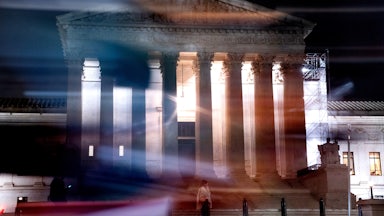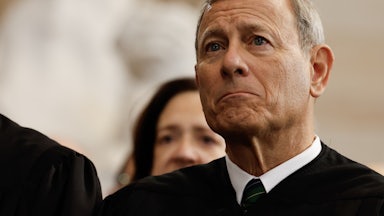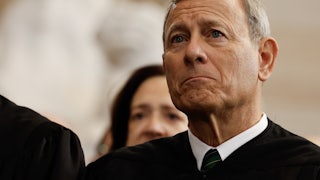The Sixth Amendment is having a constitutional moment of sorts. In 2020, the Supreme Court ruled in Ramos v. Louisiana that criminal juries across the country must be unanimous when handing down a guilty verdict. For most Americans, this may have seemed obvious. It was already the norm in 48 states and the federal government. Only Louisiana and Oregon bucked the trend. Justice Neil Gorsuch, writing for the court, reached the same conclusion.
“In all, this Court has commented on the Sixth Amendment’s unanimity requirement no fewer than 13 times over more than 120 years,” he wrote. “There can be no question either that the Sixth Amendment’s unanimity requirement applies to state and federal criminal trials equally. This Court has long explained that the Sixth Amendment right to a jury trial is ‘fundamental to the American scheme of justice’ and incorporated against the States under the Fourteenth Amendment.”
Now the Supreme Court is being asked to decide another seemingly obvious point about criminal juries: that they must consist of 12 members. Some readers might be surprised to learn that any alternative exists. But in six states—Arizona, Connecticut, Florida, Indiana, Massachusetts, and Utah—defendants in some cases can be convicted by a jury of as few as six members. A petition for review currently before the justices asks them to make 12 the magic number everywhere.
The case, Khorrami v. Arizona, began with a Los Angeles man in a relationship with a married woman in Arizona. After their relationship deteriorated in 2013, she claimed that Ramin Khorrami planned to tell her husband about the affair unless she paid him $30,000. Arizona prosecutors charged him with two state felonies: fraudulent schemes and artifices, and theft by material misrepresentation. In 2019, an eight-person jury convicted Khorrami on both counts and sentenced him to two months in jail and two years on supervised probation.
To say that an eight-person jury is unusual in the Anglo-American legal tradition would be an understatement. Popular culture invariably portrays the jury as a 12-person body; the number is so closely associated with juries that the most famous play about one is simply titled Twelve Angry Men. It is unclear when and why the number of jurors in criminal trials became fixed at 12, but the early modern English legal authorities thought it was because of the symbolic implications of the number.
Edward Coke, a preeminent English jurist in the Elizabethan era, wrote that the law “delighteth herself in the number of twelve” and noted that it was “much respected in holy writ,” citing the 12 apostles and the 12 tribes of Israel. William Blackstone wrote that no Englishman could be convicted of a crime except by “the unanimous suffrage of twelve of his equals and neighbours.” Matthew Hale, whose writings on abortion were favorably cited by Justice Samuel Alito in the court’s ruling that overturned Roe v. Wade earlier this year, once opined that if a single juror ever left town “whereby only eleven remain, these eleven cannot give any verdict without the twelfth.”
The Supreme Court only began to accept alternatives to 12 in 1970. In the case Williams v. Florida, a defendant challenged his robbery conviction by a six-person state jury as a violation of the Sixth Amendment. Justice Byron White, writing for the court, noted that history and tradition had long set 12 as the magic number for a jury of one’s peers in criminal trials. But he discarded that figure’s centrality after a functionalist analysis of the question. In his eyes, whether a jury consisted of six or 12 members made no real difference from a constitutional perspective.
“We conclude, in short, as we began: the fact that the jury at common law was composed of precisely 12 is a historical accident, unnecessary to effect the purposes of the jury system and wholly without significance ‘except to mystics,’” White wrote, quoting from a dissent by another justice in a previous case. “To read the Sixth Amendment as forever codifying a feature so incidental to the real purpose of the Amendment is to ascribe a blind formalism to the Framers which would require considerably more evidence than we have been able to discover in the history and language of the Constitution or in the reasoning of our past decisions.”
Khorrami argued in his petition that this approach to the jury-size question should be revisited after the court’s decision in Ramos two years ago. That decision overturned a 1972 ruling, Apodaca v. Oregon, where a lone justice writing for a 4–1–4 court had engaged in what Gorsuch described as a “breezy cost-benefit analysis” to conclude that nonunanimous criminal juries didn’t violate the Sixth Amendment. Gorsuch instead pointed to the historical tradition that saw jury unanimity as required, as well as the deeply racist origins of the Louisiana and Oregon laws in question in that case.
In his dissenting opinion in Ramos, Justice Samuel Alito noted that Gorsuch’s analysis could imperil other major Sixth Amendment precedents. “The Apodaca plurality’s reasoning was based on the same fundamental mode of analysis as that in Williams, which had held just two years earlier that the Sixth Amendment did not constitutionalize the common law’s requirement that a jury have 12 members,” he wrote. “Although only one state, Oregon, now permits non-unanimous verdicts, many more allow six-person juries. Repudiating the reasoning of Apodaca will almost certainly prompt calls to overrule Williams.”
Indeed, Khorrami cited Alito’s dissent in his petition for the court to do just that. He also pointed to an 1898 Supreme Court ruling in which the justices had overturned a Utah man’s conviction in that state by an eight-member jury. The court wrote in that case that “the jury referred to in the original constitution and in the Sixth Amendment is a jury constituted, as it was at common law, of twelve persons, neither more nor less.” In Khorrami’s telling, it is Williams that departed from the usual Sixth Amendment jurisprudence and the court’s understanding of the original public meaning of jury trials, not the other way around.
Arizona, for its part, urged the court not to take up Khorrami’s case on largely procedural grounds. “Unlike the defendants in Williams and Ramos, Khorrami did not receive any prison sentence for his crimes,” the state noted in its brief. “He received probation—a punishment that corresponds with a petty crime, not a serious offense.” Arizona argued that Khorrami would have to jump multiple hurdles, some of his own making, to be imprisoned under his current conviction, and thus the court would be rendering an advisory opinion on a hypothetical injury if it took up this case. Khorrami countered in a response brief that he could have been sentenced to up to 10 years in prison on each count, and argued that courts typically assess the right to a jury trial by looking at the maximum possible sentence for an offense instead of lesser alternatives.
Arizona also urged the court to maintain the status quo on smaller juries for practical reasons. “Khorrami also minimizes the enormous impact that disturbing Williams’ holding would have in Arizona, Connecticut, Florida, Indiana, Massachusetts, and Utah,” the state warned. “Announcing a new 12-member jury requirement in criminal cases would invalidate constitutional provisions and laws (that have no racist origins) in these six States, and could force the States to retry thousands of cases pending on direct appeal.” The “racist origins” parenthetical is a reference to the laws challenged in Ramos two years ago; the justices voted to overturn them in no small part because they were explicitly drafted on white-supremacist grounds in the late-nineteenth and early-twentieth centuries.
But Ramos and its aftermath also give reason to doubt Arizona’s claims of upheaval. After Ramos was decided, the court considered in Edwards v. Vannoy the following year whether to apply Ramos’s holding retroactively when state convictions were challenged in federal courts. The court had a preexisting framework for applying what it termed to be “watershed” rulings on criminal procedure that would warrant retroactivity; the question was whether Ramos met that threshold. But the Supreme Court not only ruled against retroactivity for Ramos defendants when it decided the case in 2021—it went even further and overturned the watershed framework altogether, ruling that retroactivity would not be applied by the federal courts in these circumstances in the future.
State courts, following the justices’ lead, have reached the same conclusion. The Louisiana Supreme Court ruled earlier this month that state courts would not apply Ramos retroactively to cases where the defendant had already exhausted their appeals. “The problem with retrying decades-old cases is evident in this specific case, where respondent was convicted of second degree murder nearly thirty years ago,” Justice Scott Crichton wrote for the court. “These enormous administration of justice concerns weigh strongly against retroactivity.” It is possible that other state supreme courts could reach different conclusions than this court and the Supreme Court did if Khorrami prevails, but the jurisprudential wind on retroactivity is at prosecutors’ backs, not prisoners’.
The Supreme Court hears no shortage of complex legal questions where sober jurists can reach different conclusions in good faith. It navigates some of the most incendiary issues in modern American life with, depending on your ideological persuasion, either fair-minded deftness or reckless destruction. And sometimes it is called upon to simply state the obvious. The justices will decide in the weeks ahead whether Khorrani’s case is one of those latter occasions that calls for its intervention.










